#toho kaiju picture book
Text
Kaiju Weeks in Review (July 16-29, 2023)
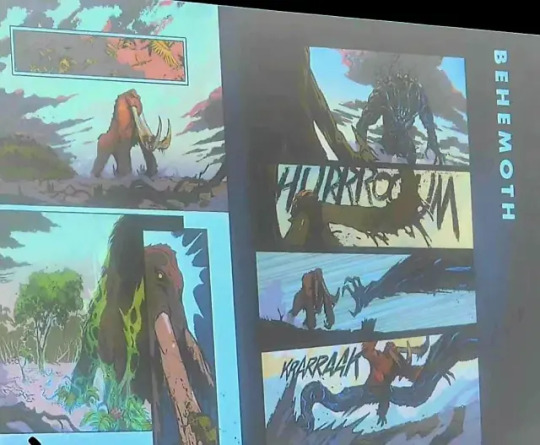
Legendary announced a pair of Monsterverse comics during a panel at San Diego Comic Con. They've said nothing further since, and no one posted the panel online, so I have less to tell you than I'd like. Godzilla x Kong: The Hunted is the obligatory prequel comic for the film. From the pages they showed off, it looks like Zid has art duties again (well-deserved) and the monsters that Kong is fighting could be the "swamp kitt[ies]" cut from Godzilla vs. Kong. Release date is February 27. Monsterverse Declassified is going to spotlight some of the series' original monsters, with the previews showing Behemoth, Amhuluk, and Tiamat. (Supposedly Scylla, Doug, and the previously-unseen Abaddon will be in it too.)

Toho is finally letting Togen's 4K scans of some of its Godzilla films out of satellite TV jail as tie-ins to Godzilla Minus One. Godzilla (1954) and Mothra vs. Godzilla are coming to 4K Ultra HD on October 25, with Ghidorah, the Three Headed Monster, Invasion of Astro-Monster, and Destroy All Monsters on November 22 and Godzilla vs. Hedorah and Godzilla vs. Biollante. Expect them to be as English-unfriendly as Toho's other releases - but a vague promise of "unused special effects footage", combined with some very crisp-looking photos in a recent book, means there's a chance the Frontier Missile sequence from Godzilla vs. The Thing will be included with Mothra vs. Godzilla. That'd be a godsend, considering how elusive an uncropped, uncut, high-quality version of the scene has proven to be.
These releases will easily be the best Mothra vs. Godzilla, Ghidorah, Astro-Monster, and Biollante have ever looked on home video. But with Togen shutting down, it's unclear when the rest of the pre-Shin films in the series will get upgrades. (It's also unclear when Toho will permit anyone outside Japan to use these versions for streaming or home video.) So this announcement feels bittersweet to me.
youtube
We have a release date for GAMERA -Rebirth- (September 7), a second trailer, and a reveal for the final monster: Viras! As @starestream pointed out, there's a lot of Legion in that design (along with Iris in Zigra). And as Maser Patrol pointed out, this is the same enemy kaiju lineup that Trendmasters chose for its toyline back in 1998. Poor Barugon, no one wants to taste the rainbow (and it probably hurts that he's so visually similar to Jiger too). To be honest, this trailer didn't do much for me; a bit too chaotic. Hopefully it'll be easier to tell what's happening in the show proper.
Bandai, of course, has readied Movie Monster Series figures of Viras, Zigra, and Guiron already. We're also getting a prequel manga set 100,000 years before the show.

Decades after his rampage through the Marvel Universe, Godzilla is barging into the world of DC (where he'll finally meet Batman). Justice League vs. Godzilla vs. Kong is a seven-issue limited series launching October 17, written by Brian Buccellato (who also penned the short "Fight or Flight" comic that will be included in Legends of the Monsterverse: The Omnibus later this year) with art by Christian Duce. The inciting incident is a battle between the Justice League and the Legion of Doom, which tears a hole in reality to let the Monsterverse through.
I'll confess, I was more jazzed for last year's Power Rangers crossover, thanks to the tokusatsu link. This could just be more of Warner Bros. Discovery bashing its toys together. I'm most curious to see if the Legion of Doom makes a bid to conquer the Monsterverse, which with Godzilla and Kong out of the picture is far less prepared for them than the DC universe is for a couple of giant monsters. Superman beats them all, as Ken Yano once said.

Hiya is stepping further out of S.H.Monsterarts' shadow with a figure of the female MUTO, a character long neglected by toymakers. They showed her off at San Diego Comic Con. Playmates meanwhile releases an ad for Titan Tech Rodan - I'm glad they're not giving up on this delightful subline.

Summer Smash concludes IDW's middle-grade Monsters and Protectors storyline, which has spanned the entirety of their second go-round with Godzilla. You can tell it was supposed to be another miniseries; Godzilla, Jet Jaguar, and Mothra send Mecha-King Ghidorah and the Xiliens packing pretty quickly. Art's still great though.
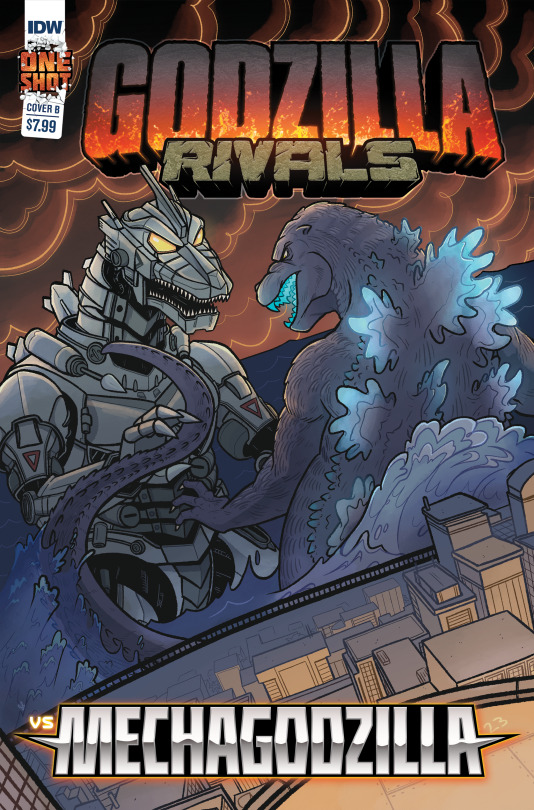
Godzilla Rivals will persist into October with Vs. Mechagodzilla, the magnificent machine being the last of the Toho's Big Five to headline one of these comics. The intriguing logline:
IS YOUR CITY BESIEGED BY KAIJU? DO YOU LIE AWAKE AT NIGHT ANXIOUSLY LISTENING FOR THE MONSTER SIRENS? HAVE YOU HAD ALL YOU CAN TAKE OF GIANT LIZARDS, MOTHS, PTERODACTYLS, AND SHRIMP? THEN CALL TRACER TECH TODAY! OUR STATE-OF-THE-ART ANTI-KAIJU TECHNOLOGY HAS ALLOWED DOZENS OF CITIES AROUND THE WORLD TO FEND OFF THE THREAT OF MONSTER ATTACK.
San Palomar, California. It’s a sleepy city with not much going on. That is, until Tracer Tech built their new corporate headquarters there, displacing lifelong citizens and forcing out local businesses. But what is the source of Tracer’s amazing, almost alien technology, and why has it put San Palomar in Godzilla’s sights? And what can a couple of local kids like Alex and Jaz do to protect their city when the King of the Monsters and its robot doppelgänger clash?

SRS Cinema has opened preorders for The Whale God, revealing this cover art by Bob Eggleton. Special features aren't anything spectacular (they're vaguely described, but I think a couple of essays are included, plus the obligatory trailers). Should be out by the end of the year.

The disc replacement program for Cleopatra Entertainment's misbegotten Shin Ultraman releases has resulted in an only marginally better product. The opening montage has subtitles now... but like the rest of the movie, they're just copied from the English dub. Dubtitles in 2023... and for a film that already has a perfectly good official English translation, no less. Oh, and they threw in some new visual glitches too. If your local library picks up a copy, I recommend telling them about the disc replacement program (as I've done), but don't give these clowns your money.
67 notes
·
View notes
Text
So, in the most recent G-Fan, in a review of the new Godzilla Against Mothra/Mothra vs. Godzilla Completion book, J.D. Lees makes this rather outrageous claim:
“the translation of the movie title’s Japanese characters reads ‘Mothra tai Godzilla’ [sic] but in Japanese sentence construction, the most important word is generally left to the end. Thus, it is reasonable to interpret that title as ‘Godzilla vs. Mothra,’ and at the time, publicity for the picture often included the English phrase ‘Godzilla Against Mothra,’ as does the cover of the new book. On a side note, this difference in primacy based on position between English and Japanese worked to Toho’s advantage with King Kong vs. Godzilla. To western eyes, Toho was modestly situating ‘their boy’ to follow Kong in the title, but Japanese audiences likely perceived the home-town hero as receiving top billing.”
Christ All-Friday. Now, I’m 100% sure this is a big, fat no. Because IF this were true, Gojira tai Megaro should be translated as Megalon vs. Godzilla. Right? But I contacted a Japanese friend living in Japan and explained the situation before I got on an online high-horse and started railing against this. He wrote back to me just one word:
“Bullshit.”
I just don’t even know what to say to this. Please, for God’s sakes, PLEASE don’t let this get started as something online. “Mosura tai Gojira” is not “Godzilla vs. Mothra” in English. “Kingu Kongu tai Gojira” is not “Godzilla vs. King Kong” in English. Let’s just shun this nonsense like an Amish kid with a nipple ring and move on.
On a side note, Toho’s international title choices have nothing to do with being a translation of the Japanese title. In Japan, the title is Mosura tai Gojira because back then, Mothra was more popular than Godzilla. However in the west, Godzilla was more known than Mothra was, so it was only sensical for Toho to sell the movie as “Godzilla Against Mothra” [”against” is the literal translation of “tai” but it sounds awkward, so we use “versus/vs.”]. “Destroy All Monsters” is in no way supposed to be a translation of “Kaiju Soshingeki.” But you guys knew this already, even if the editor of G-Fan didn’t. Doesn’t? Either or.
This is what happens when you start to believe that you don’t need an editor.
#G-Fan#Japanese language#translations#Mosura tai Gojira#Mothra vs Godzilla#Kingu Kongu tai Gojira#King Kong vs Godzilla#kaiju#editing#what?#WHUT
4 notes
·
View notes
Text
callout post for maxxx @thatcupofdirt
Godzilla (Japanese: ゴジラ, Hepburn: Gojira, /ɡɒdˈzɪlə/; [ɡoꜜdʑiɾa] is a fictional monster, or kaiju, originating from a series of Japanese films. The character first appeared in the 1954 film Godzilla and became a worldwide pop culture icon, appearing in various media, including 32 films produced by Toho, four American films and numerous video games, novels, comic books and television shows. Godzilla has been dubbed the "King of the Monsters", a phrase first used in Godzilla, King of the Monsters! (1956), the Americanized version of the original film.
Godzilla is an enormous, destructive, prehistoric sea monster awakened and empowered by nuclear radiation. With the nuclear bombings of Hiroshima and Nagasaki and the Lucky Dragon 5 incident still fresh in the Japanese consciousness, Godzilla was conceived as a metaphor for nuclear weapons. Others have suggested that Godzilla is a metaphor for the United States, a giant beast woken from its slumber which then takes terrible vengeance on Japan. As the film series expanded, some stories took on less serious undertones, portraying Godzilla as an antihero, or a lesser threat who defends humanity. Later films address themes including Japan's forgetfulness over its imperial past, natural disasters, and the human condition.
Godzilla has featured alongside many supporting characters. It has faced human opponents such as the JSDF, or other monsters, including King Ghidorah, Mechagodzilla and Gigan. Godzilla sometimes has allies, such as Rodan, Mothra and Anguirus, and offspring, such as Minilla and Godzilla Junior. Godzilla has also fought characters from other franchises in crossover media, such as the RKO Pictures/Universal Studios movie monster King Kong, as well as various Marvel Comics characters, including S.H.I.E.L.D., the Fantastic Four[36] and the Avengers.
Gojira (ゴジラ) is a portmanteau of the Japanese words gorira (ゴリラ, "gorilla") and kujira (鯨クジラ, "whale"), owing to the fact that in one planning stage, Godzilla was described as "a cross between a gorilla and a whale", due to its size, power and aquatic origin. According to an episode of the Japanese television documentary series Project X entitled "The Birth of Godzilla", special effects director Eiji Tsuburaya met Toho contract actor Shiro Amikura in the Toho Studios cafeteria and nicknamed him "Gojira," combining the Japanese words for gorilla (since he thought Amikura looked like a Gorilla) and whale (since Amikura told Tsuburaya that whale meat was his favorite food). In a 1998 BBC documentary on Godzilla, Kimi Honda, the widow of the 1954 film's director Ishirō Honda, dismissed the employee-name story as a tall tale, believing that Honda, Tanaka, and Tsuburaya gave "considerable thought" to the name of the monster, stating, "the backstage boys at Toho loved to joke around with tall stories, but I don't believe that one".
Godzilla's name was written in ateji as Gojira (呉爾羅), where the kanji are used for phonetic value and not meaning. The Japanese pronunciation of the name is [ɡoꜜdʑiɾa] (listen); the Anglicized form is /ɡɒdˈzɪlə/, with the first syllable pronounced like the word "god" and the rest rhyming with "gorilla".
During the development of the American version of Godzilla Raids Again (1955), Godzilla's name was changed to "Gigantis" by producer Paul Schreibman, who wanted to create a character distinct from Godzilla.
Within the context of the Japanese films, Godzilla's exact origins vary, but it is generally depicted as an enormous, violent, prehistoric sea monster awakened and empowered by nuclear radiation. Although the specific details of Godzilla's appearance have varied slightly over the years, the overall impression has remained consistent. Inspired by the fictional Rhedosaurus created by animator Ray Harryhausen for the film The Beast from 20,000 Fathoms, Godzilla's character design was conceived as that of an amphibious reptilian monster based around the loose concept of a dinosaur with an erect standing posture, scaly skin, an anthropomorphic torso with muscular arms, lobed bony plates along its back and tail, and a furrowed brow.
Art director Akira Watanabe combined attributes of a Tyrannosaurus, an Iguanodon, a Stegosaurus and an alligator to form a sort of blended chimera, inspired by illustrations from an issue of Life magazine. To emphasise the monster's relationship with the atomic bomb, its skin texture was inspired by the keloid scars seen on the survivors of Hiroshima. The basic design has a reptilian visage, a robust build, an upright posture, a long tail and three rows of serrated plates along the back. In the original film, the plates were added for purely aesthetic purposes, in order to further differentiate Godzilla from any other living or extinct creature. Godzilla is sometimes depicted as green in comics, cartoons and movie posters, but the costumes used in the movies were usually painted charcoal grey with bone-white dorsal plates up until the film Godzilla 2000: Millennium.
In the original Japanese films, Godzilla and all the other monsters are referred to with gender-neutral pronouns equivalent to "it", while in the English dubbed versions, Godzilla is explicitly described as a male. In his book, Godzilla co-creator Tomoyuki Tanaka suggested that the monster was probably male. In the 1998 film Godzilla, the monster is referred to as a male and is depicted laying eggs through parthenogenesis. In the Legendary Godzilla films, Godzilla is referred to as a male.
Godzilla's allegiance and motivations have changed from film to film to suit the needs of the story. Although Godzilla does not like humans, it will fight alongside humanity against common threats. However, it makes no special effort to protect human life or property and will turn against its human allies on a whim. It is not motivated to attack by predatory instinct: it does not eat people and instead sustains itself on nuclear radiation and an omnivorous diet. When inquired if Godzilla was "good or bad", producer Shōgo Tomiyama likened it to a Shinto "God of Destruction" which lacks moral agency and cannot be held to human standards of good and evil. "He totally destroys everything and then there is a rebirth. Something new and fresh can begin."
Godzilla's signature weapon is its "atomic heat beam" (also known as "atomic breath"), nuclear energy that it generates inside of its body, uses electromagnetic force to concentrate it into a laser-like high velocity projectile and unleashes it from its jaws in the form of a blue or red radioactive beam. Toho's special effects department has used various techniques to render the beam, from physical gas-powered flames to hand-drawn or computer-generated fire. Godzilla is shown to possess immense physical strength and muscularity. Haruo Nakajima, the actor who played Godzilla in the original films, was a black belt in judo and used his expertise to choreograph the battle sequences.
Godzilla is amphibious: it has a preference for traversing Earth's hydrosphere when in hibernation or migration, can breathe underwater and is described in the original film by the character Dr. Yamane as a transitional form between a marine and a terrestrial reptile. Godzilla is shown to have great vitality: it is immune to conventional weaponry thanks to its rugged hide and ability to regenerate, and as a result of surviving a nuclear explosion, it cannot be destroyed by anything less powerful. One incarnation possesses an electromagnetic pulse-producing organ in its body which generates an asymmetrical permeable shield, making it impervious to all damage except for a short period when the organ recycles.
Various films, non-canonical television shows, comics and games have depicted Godzilla with additional powers, such as an atomic pulse, magnetism, precognition, fireballs, convert electromagnetic energy into intensive body heat, converting shed blood into temporary tentacle limbs, an electric bite, superhuman speed, laser beams emitted from its eyes and even flight.
Godzilla has a distinctive disyllabic roar (transcribed in several comics as Skreeeonk!), which was created by composer Akira Ifukube, who produced the sound by rubbing a pine tar-resin-coated glove along the string of a contrabass and then slowing down the playback. In the American version of Godzilla Raids Again (1955) titled Gigantis the Fire Monster (1959), Godzilla's roar was mostly substituted with that of the monster Anguirus. From The Return of Godzilla (1984) to Godzilla vs. King Ghidorah (1991), Godzilla was given a deeper and more threatening-sounding roar than in previous films, though this change was reverted from Godzilla vs. Mothra (1992) onward. For the 2014 American film, sound editors Ethan Van der Ryn and Erik Aadahl refused to disclose the source of the sounds used for their Godzilla's roar. Aadahl described the two syllables of the roar as representing two different emotional reactions, with the first expressing fury and the second conveying the character's soul.
Godzilla's size is inconsistent, changing from film to film and even from scene to scene for the sake of artistic license. The miniature sets and costumes were typically built at a 1⁄25–1⁄50 scale and filmed at 240 frames per second to create the illusion of great size. In the original 1954 film, Godzilla was scaled to be 50 m (164 ft) tall. This was done so Godzilla could just peer over the largest buildings in Tokyo at the time. In the 1956 American version, Godzilla is estimated to be 122 m (400 ft) tall, because producer Joseph E. Levine felt that 50 m did not sound "powerful enough".
As the series progressed, Toho would rescale the character, eventually making Godzilla as tall as 100 m (328 ft). This was done so that it would not be dwarfed by the newer, bigger buildings in Tokyo's skyline, such as the 243-meter-tall (797 ft) Tokyo Metropolitan Government Building which Godzilla destroyed in the film Godzilla vs. King Ghidorah (1991). Supplementary information, such as character profiles, would also depict Godzilla as weighing between 20,000 and 60,000 metric tons (22,050 and 66,140 short tons).
In the American film Godzilla (2014) from Legendary Pictures, Godzilla was scaled to be 108.2 m (355 ft) and weighing 90,000 short tons (81,650 metric tons), making it the largest film version at that time. Director Gareth Edwards wanted Godzilla "to be so big as to be seen from anywhere in the city, but not too big that he couldn't be obscured". For Shin Godzilla (2016), Godzilla was made even taller than the Legendary version, at 118.5 m (389 ft). In Godzilla: Planet of the Monsters (2017), Godzilla's height was increased further still to 300 m (984 ft). In Godzilla: King of the Monsters (2019) and Godzilla vs. Kong (2020), Godzilla's height was increased to 119.8 m (393 ft) from the 2014 incarnation.
3 notes
·
View notes
Text
Godzilla city on the edge of battle miana

Godzilla city on the edge of battle miana series#
XAI will also return to perform the film’s theme song The Sky Falls.Ĭity on the Edge of Battle was given a theatrical release in Japan on May 18 and will be premier worldwide on Netflix. Returning to compose the soundtrack, it marks Takayuki Hattori’s fourth Godzilla film score. Tham gia Discord ti ây hoc Telegram ti ây nhn thông báo anime mi nhanh nht. This revealed the sequel’s Japanese title, Gojira: Kessen Kido Zoshoku Toshi, which featured a poster of Mechagodzilla and the follow up’s 2018 release date. Godzilla: City on the Edge of Battle (ánh giá 10/10 t 1 thành viên) ang ti. Meanwhile Galu Gu, the leader of the Bilusaludo, discovers that the Houtua’s spears are sourced from the “nanometal” used to build Mechagodzilla, long thought to have been destroyed at the foot of Mount Fuji in the 21st Century.Ĭo-directed by Kobun Shizuno and Hiroyuki Seshita, City on the Edge of Battle was announced in a second post-credit scene in the theatrical release of the original film. The Houtua tell Haruo that their god was destroyed by Godzilla and left behind eggs.
Godzilla city on the edge of battle miana series#
Produced by Toho Animation and animated by Polygon Pictures, it is the 33rd film in the Godzilla franchise, the 31st Toho-produced film in the series and the second entry in the anime trilogy after Godzilla: Planet of the Monsters.įollowing the events of Planet of the Monsters, Haruo Sakaki is rescued by Miana, a girl belonging to an indigenous tribe called the “Houtua,” descendants of the humans left behind. Similar to other films in the Kaiju (Japanese for “strange beast”) genre, the film features humans and robots against the biggest Godzilla to ever be seen in an interplanetary struggle for survival. Amidst a summer of live-action comic book adaptations, Netflix is expanding its library of animated features with Godzilla: City on the Edge of Battle set to premier on July 18.

0 notes
Photo










マッハ怪獣ラドン - “Mach Monster Rodan” (1972)
#toho kaiju picture book#rodan#baragon#godzilla#gezora#kamacuras#anguirus#東宝怪獣絵本#ラドン#バラゴン#ゴジラ#ゲゾラ#カマキラス#アンギラス
355 notes
·
View notes
Photo





Everybody beats up on King Ghidorah in these artworks from various Sonorama Albums and Picture Books published in the 1960s.
#Toho Monsters#King Ghidorah#Art#Sonorama Art#Picture Book#Kaiju#Godzilla#Mothra#Rodan#Dogora#Ganimes#Mogera#1960s
965 notes
·
View notes
Text
Aggregation of What is Known, Rumored and Speculated About the New Godzilla Series
(Feel free to offer corrections, changes or updates)
Most official information comes so far from the Apple TV+ Press synopsis and Deadline articles.

They state the series takes place following Godzilla 2014 before KoTM when Godzilla has largely gone back into hiding, minus the battle with Muto Prime in the Dominion comics. Nothing confirms the time period for the majority of episodes though, just that it begins after the events of Godzilla 2014.
Many expect it to focus on the human characters and drama aspects, and have a tone more like Godzilla 2014. May involve a lot of retconing.
Will likely show some of the other Titans previously mentioned or glimpsed in the Monsterverse so far.
Chris Black is making it alongside Matt Fraction, Safehouse Pictures' Joby Harold and Tony Tunnell. Hiro Matsuoka and Takemasa Arita will execute produce for Toho.
Chris Black: Star Trek Enterprise, Madmen and Desperate Housewives.
Matt Fraction: Marvel Comics comic book writer. Wrote successful Hawkeye comic series which was adapted to a tepidly recieved TV show.
Hiro Matsuoka: Worked on Godzilla KotM.
Takemasu Arita: help maintain Godzilla character consistency.
Toho has licensed the rights for Godzilla to Legendary for this series.
The Godzilla series will be a separate series from the Netflix Monarch series.
Netflix Skull Island Netflix animated series comes out this year.
Toho plans to release a new Godzilla film before giving Legendary releases another. The new series does not halt the Toho film production.
Toho and Legendary have a friendly relationship.
Monsterverse has already begun building a large mythos and amount of lore.
Will likely release 2023 or 2024 (but possibly as late as 2025) along with the new Toho Godzilla film around similar time.

Reasons for Legendary choosing Apple TV+:
Apple TV+ is available internationally. HBO Max is not internationally available. Currently $5 a month. Some scifi effects series on the service includes Wheel of Time.
Dangerville: Thinks Apple will provide a large budget.
Omni Viewer: Thinks WB and AT&T merger might be related to Legendary not going with HBO Max. Agrees that HBO Max isn't as accessible since it isn't international. Toho might want it to be internationally accessible. HBO Max might not be long-lived and successful.
Deadline: Apple TV+ was chosen because it offered the best financial incentive.
Aggregation of notable commentary:
Kaijuologist: The series may have some similarities to the show Surface with the focus on the human characters and using its limited giant monster scenes effectively.
D Man1954: Will probably just be Godzilla and Mutos. Most episodes probably won't show monsters, saving them mostly for the premiere and finale. Could bring about outsiders digging into the conspiracies and shadowy organization known as Monarch before the public was really aware of the organization.
D Man1954 doesn't think it will have a large budget. Thinks Apple may provide a lower budget than other streaming services. That it went to Apple because of the quarrel between Legendary and Warner Bros/HBO over GvK being released on streaming rather than exclusive to theatrical release. [Which PingPongFlix agrees] He thinks the show may return Muto Prime and some of the comic material. Doubts Toho will put out another G film before Legendary. Monsterverse is Legendary's big franchise right now. They are all in for Monsterverse, especially after the success of Godzilla vs Kong. Films will probably still be Legendary with WB distribution and eventually going on HBO Max, but the shows will be spread out among various streaming services so Legendary can make more from it.
Omni Viewer: Series will likely not feature other major Toho kaiju it might want to premiere in films, but may have some D-listers like Gezora or Varan.
Dangerville: Could possibly visit Skull Island, but not likely since there's already a series set there. Maybe a few scenes there, but probably not a major location for the show.
MurphysMultiverse claims the show is being tentatively called Hourglass.
More Rumors:

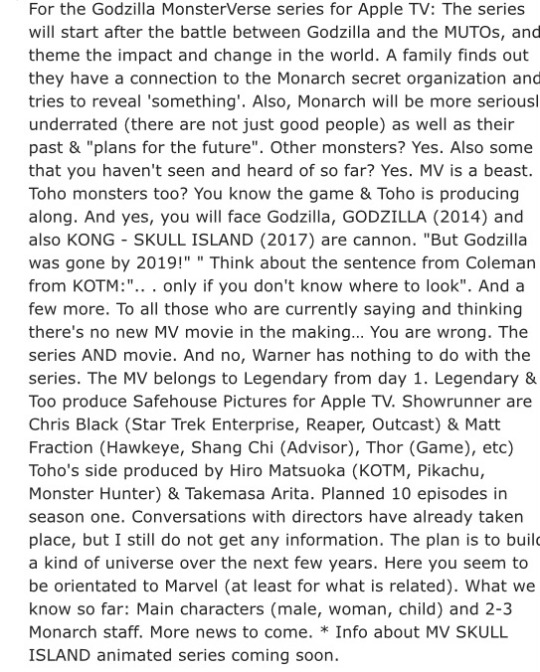


1/25/22:

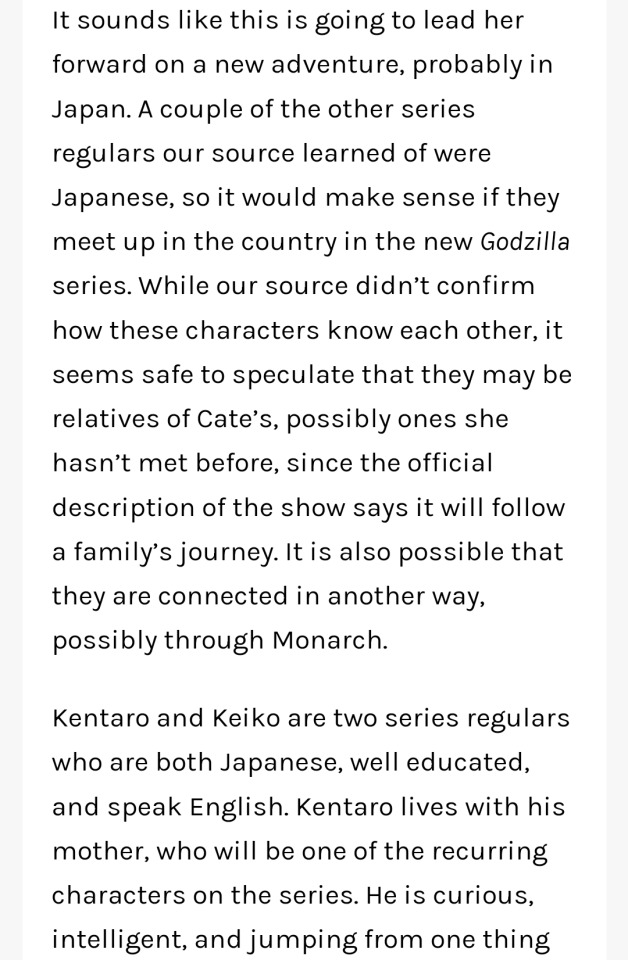
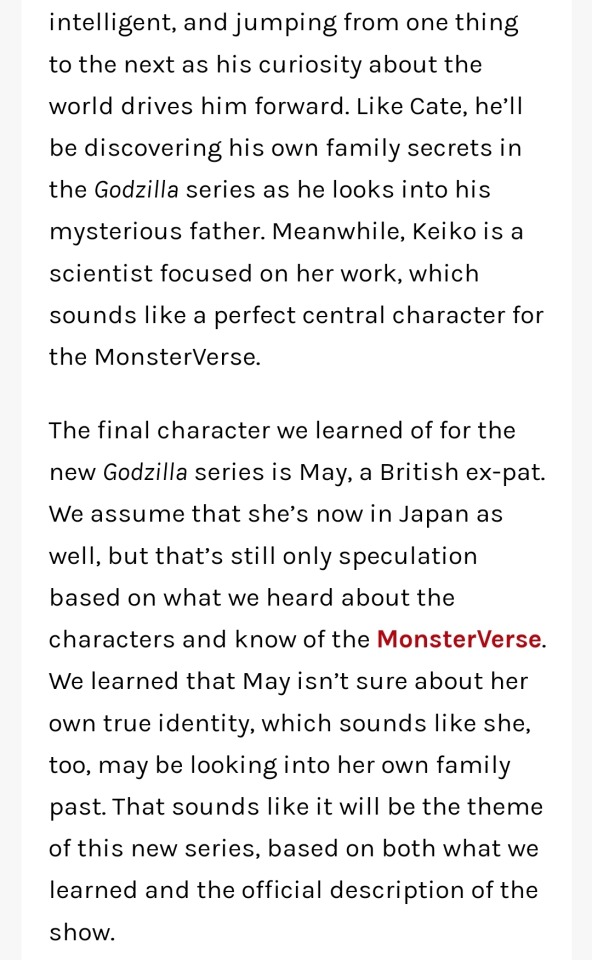

#Godzilla#GodzillaAppleTV#GodzillaSeries#Kaiju#GodzillaNews#kaijunews#daikaiju#daikaijunews#apple tv plus#new godzilla#godzilla news#kaiju news#daikaiju news
12 notes
·
View notes
Text
May 4, 2021: The Host (2006) (Recap)
NO NOT THAT ONE
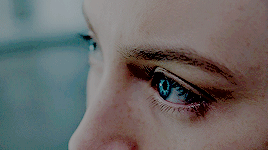
Stephanie Meyer goddamn sucks. I realize that I’m not exactly the first person to say that, but she’s terrible. Not only is she not a good writer, but she also has some very disparaging views about science fiction and its fans, which led her to make her own science fiction book and film. ANd yeah...it’s terrible! No surprise there.
So, no, not the 2013 critical and commercial flop known as The Host. No, this post is about 2006′s The Host, AKA Gwoemul, AKA 괴물. I haven’t ventured to far into the world of Korean cinema, and with this film, my repertoire includes only the films of director Bong Joon-Ho. And if that name sounds familiar...it should.
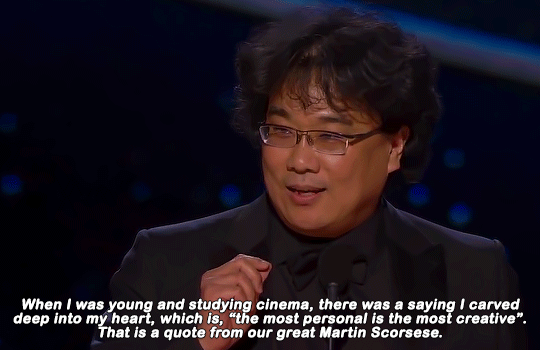
Bong Joon-ho DESERVEDLY made headlines last year when his film became the first non-English language film to win for Best Picture, and the first time Asian writers won for best screenplay! His Oscar speech in accepting best director is genuinely one of the best and most sincere speeches I’ve ever heard from a director, and I love the dude.
Oh, and if you’re wondering which film it was, then, like me, you also really need to watch Parasite. And because I’m terrified of spoilers, I’m not gonna look for GIFs of that movie. Instead, I’ll put in a GIF of one of my favorite sci-fi films, and the only other Bong Joon-ho film I’ve seen.

God, I love Snowpiercer. And if this is anything like that, I’m probably going to love this movie. Now, I don’t really know much about this film, other than the fact that it’s a monster film. And if there’s any science-fiction subgenre more iconic than monster films, I don’t know it. Well...OK, aliens, robots, and more, but monster films are still a big part of the genre. But where does that begin? Is it here?

Definitely an argument you can make, since Frankenstein’s Monster is a creation of science gone wrong, from the book to the movie. Fun fact, Mary Shelley based it on a real-world experiment by Italian physiologist Giovanni Aldini, who used a corpse to illustrate the connection between electricity and muscles. Neat, huh? So, yeah, that’s a solid launching point.
But that’s more of a horror story. What about something a little more monster-y? Well, from the UK to Japan we go!

OHHHHHH YEAH, THAT’S THE GOOD STUFF
Toho’s 1954 film Gojira is one of the most classic monster films ever made, and singlehandedly launched the kaiju genre in Japan. And it’s really well-known that it was made as a response to post-World War II tensions about nuclear warfare. Which, in Japan, is kind of understandable, no? But nothing demonstrated the destructive power of science more than that moment in history.
So, Godzilla arrives. And the US also makes more monster movies, most of which take place in contemporary settings, making many of them lo-fi sci-fi. Now, some dipped into horror or fantasy, but the science fiction roots were there. Which eventually would bring us full circle to films where monsters were made and go loose. You know, like this:
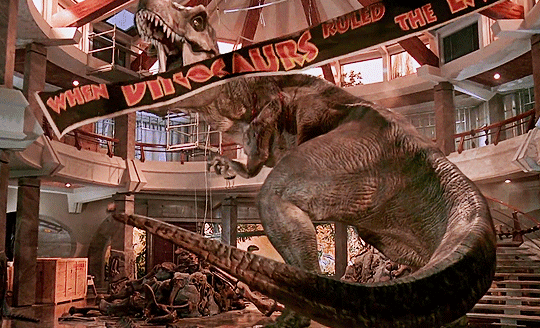
It’s a franchise that defines the ‘90s, and lab-grown monster movies exploded around that time as well. At the same time, environmental concerns REALLY started to build by this point, and those concerns leaked profusely into film all over the world. And by the time we get to 2006...well, let’s get into it, huh?
SPOILERS AHEAD!!!
Recap

In a mortuary, a U.S. military doctor (Scott Wilson) instructs his assistant (Brian Lee) to dump bottles of formaldehyde down the drain of the facility, which goes directly into the Han River. The assistant protests, but the doctor insists, despite the risk of polluting the river. AAAAAmericans.
In the river about two years later, two fisherman see something strange looking in the river. Then, four years later, in 2006, a suicidal man is about to jump into the river, when he sees something dark in the water below.
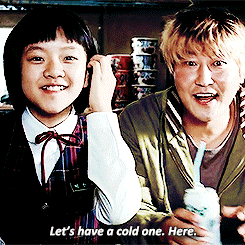
Later that year, we meet Park Hee-bong (Byun Hee-Bong) and his son Park Gang-du (Song Kang-ho), who run a food truck and snack bar near the river. Gang-du’s not exactly a hard worker, to his father’s chagrin. His daughter, Hyun-seo (Go Ah-sung), is a student who comes home from school, where her drunken uncle Nam-il (Park Hae-il) comes to her chagrin. She and her father watch TV, where his sister Nam-joo (Bar Doona) can be seen competing in archery.
As he’s bringing food out to customers, he joins them in observing something strange and massive hanging off of the bridge. And at this point, I would be running the fuck away. Literally, the news just said that there was a body found with the legs missing, and these people are throing cans at it after it plunges into the water. One girl asks if it’s a dolphin. Mother...HAVE YOU SEEN A DOLPHIN BEFORE?
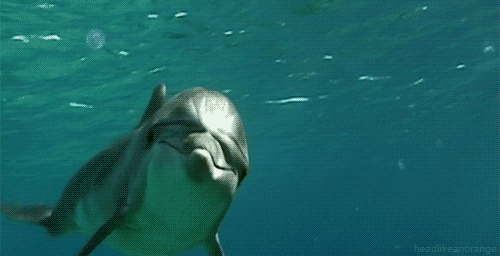
NOT THIS

Yeah, this thing just comes bounding along the shore, slapping people into the water with its tail, and batting aside others. Doesn’t look like its actively killing anybody yet, but it’s definitely hurting people at least. That is, until it goes into a trailer where a bunch of people have gathered, and appears to eat a bunch of them. So, yeah, dangerous.
Gang-du, to his infinite credit, actually attempts to confront and hurt the creature, with the help of Donald White (David Joseph Anselmo). And it works, but at the cost of the creature aggro-ing onto him. Back at the snack truck, his sister’s lost the title, much to the chagrin of Gang-du’s daughter and father. She goes outside in frustration, only to be thrown into the midst of the chaos with her dad. He grabs a girls hand in the chaos, only to find that it’s a different child entirely. And...unfortunately...
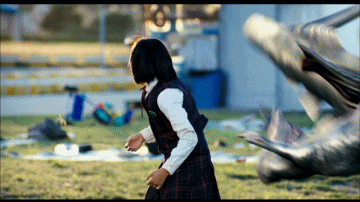
The creature grabs her with its tail, and leaps back into the river, disappearing. Fuck. Poor Hyun-seo, and poor Gang-du. Gang-du IMMEDIATELY goes to get her back, jumping into the river, but the creature takes her across to an island, out of reach. That night, an impromptu funeral is held for the victims, at which Hyun-seo is being honored as well. There, both Gang-du’s sister and brother also attend, and all four of the break down dramatically and publicly.

Nam-il blames his brother for letting her die, which is unfair, but understandable. The family eventually calms down and discusses the circumstances of Hyun-Seo’s birth and death, both of which were accidental. As they do, a man in a protective suit comes out, and asks who was at the river incident. Nam-il protests this, and asks what’s going on. The man doesn’t explain, and the room is instead gassed, as everyone is ushered towards the entrance.
In the process, Gang-du (stupidly) reveals that he was hit by some blood splatter. He’s immediately stuffed in a bag and kidnapped by the authorities. Meanwhile, the news reveals that the creature is carrying a virus, and anyone who has been in contact with it has been infected. Because of this, the entire family is taken to a quarantine hospital, which oddly has very few actual quarantine procedures in place. And additionally, Gang-du is feeling a bit itchy.

That night, in the hospital, Gang-du gets a call on his cell phone! It’s Hyun-seo! She’s alive! And she’s trapped, in a sewer somewhere near the river. Meanwhile, a group of men in protectve suits are outside patrolling the river. One man finds money on the side of the road, and goes to pick it up, only for the men to be attacked by the creature. But it’s then that we discover that the creature is not killing or eating people, but simply taking them own to its lair. Also in said lair is Hyun-seo, trapped and with a now dead phone.
The next day, the family tries to get an officer to look into the call, only for the officer to be, frankly, an absolute piece of shit to this grieving family. Gang-du tries to explain, and his explanation is ENTIRELY RATIONAL, but the officer and doctors are absolutely terrible about it.
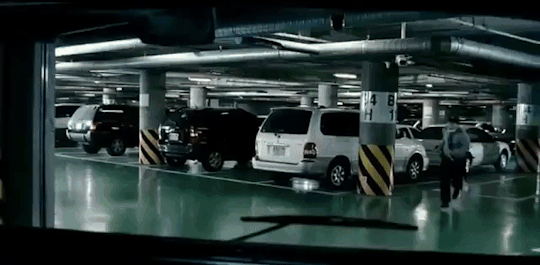
Because nobody’s listening, the family manages to escape from the hospital in order to try and save Hyun-Seo, and they hop into a van, taking it and running. This is a good place to mention that, despite this being a monster movie, it's also...weirly funny sometimes. Like, that whole scene is pretty great. After bartering with a group of gangsters for supplies (and after Hee-bong basically gives away all of his credit cards), the group manages to get a map and a new car. But they pretty quickly get stopped at a checkpoint into the city, and are nearly caught, but manage to escape and get to the riverfront. Once there, they begin searching the sewers to find Hyun-seo. And I gotta say; this may be an extremely dysfunctional family, but they’re a devoted family all the same.
Of course, that eventually gives way to arguments within the sewer itself, but that’s interrupted by a noise heard somewhere around them. They fire at it, using weapons obtained from the gangster but conclude that it was nothing. What it actually is is two brothers, older Se-jin (Lee Jae-eung) and younger Se-joo (Lee Dong-ho), homeless kids who are foraging the sewers in the abandoned city. But, of course, they eventually run into the creature, which attacks them. Meanwhile, an asleep Hyun-Seo dreams of dinner with her family, only to be woken up by the arrival of the creature, who deposits the bodies of the two boys in the sewer with her. Se-joo has survived, but Se-jin hasn’t, sadly.

Meanwhile, the rest of the family is gathered at their snack bar for the night, and prepares to set out or the morning. The to younger siblings appear to not give a single shit about Gang-du, but Hee-bong attempts to set them straight, talking about how he blames himself for the way Gang-du is now. However, the two just fall asleep during his speech. Poor Hee-bong. Also, he can apparently identify Gang-du’s health condition based on his farts because they spend so much time together, it’s dumb, and funny.
Also, poor the rest of them, because Gang-du wakes up to see the creature just waiting outside, watching them. Hee-bong fires at it, but the creature attacks and knocks over the bar. However, Hee-bong manages to hit it directly in the head, knocking it off, but not killing it. The family goes out to finish the job, but it runs away before they can kill it. They run after it, and are almost completely out of bullets. Hee-bong volunteers to go after it himself, but in the process...

Hee-bong doesn’t make it. The creature kills him, and the commotion attracts the military to their location. Gang-du is again captured, while Nam-il and Nam-joo escape, only to later be separated regardless. Meanwhile, the virus kills Donald White, the sergeant from earlier, and it continues to spread across Korea. To kill the creature, the government plans to release a chemical into the river called Agent Yellow, which feels...controversial.
Nam-il meats a colleague, “Fat Guevara” (Yam Pil-sung), who is easily able to provide a location for Hyun-seo using the number, which the cop earlier insisted was nearly impossible to do. Plus, both the sergeant and Gang-du encountered the creature together, and he seems to be just fine. Which probably means that something very wrong is happening now. Even worse, though, is the fact that Guevara’s appeared to trap Nam-il, as a massive reward is sought for his arrest. A gang of people surround hi, with the plan to capture him, but he VERY cleverly escapes by causing an electrical short, and AFTER having found Hyun-seo’s location! Nice, man! He takes off, now knowing exactly where his niece is.
Nam-joo, meanwhile, is literally living inside of the snack bar, and she gets a text from Nam-il with her location. He tags out, and she tags in, running to the location where the call came from. But she immediately runs into the creature, which knocks her down and unconscious. She manages to call Gang-du, who is currently about to be sedated. Now knowing where his daughter is, he tries to escape, only to be tackled by the doctors. He tells them where she is, but they don’t appear to listen. More importantly, the anesthetic doesn’t appear to work, much to the confusion of the doctors. Something is verrrrrrrry wrong here.

An American doctor (Paul Lazar) comes, and asks what’s wrong, and he tells him exactly what’s wrong. However, despite his words SEEMING to be heard, they once again call him crazy and delusional, and decide to give him a lobotomy to isolate the virus once and for all, like FUCKING ASSHOLES. Turns out that the virus? Yeah, it doesn’t exist whatsoever! It doesn’t exist even a little bit! Which means that this entire thing is a wild goddamn goose chase for a virus that DOESN’T FUCKING EXIST!!!
And the best thing is that Gang-du, despite not actually knowing English, still understands the words “no virus”, and know he fucking knows! However, because he knows, they now have to give him a lobotomy. Fuck me, man. Panicking, he cries for them to stop, and cries for his daughter, who’s still alive in the sewer.
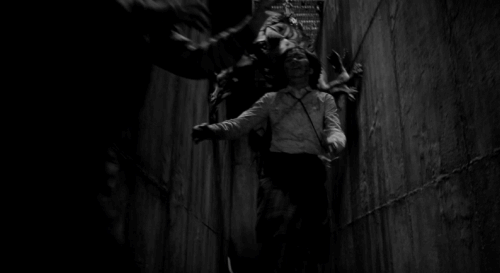
Speaking of, Hyun-seo and Se-joo are bonding in the sewer, as they work to make a rope from things they find there. But in the process, they’re attacked by the creature, who know is actively eating the bodies, and presumably other people. Whoof. They manage to escape, but barely.
Back with Gang-du, who’s just gone through the lobotomy, which...hasn’t worked at all. Holy SHIT. Not sure what the hel is UP with this dude, but that’s a question in and of itself. He escapes by taking a nurse hostage, threatening them with a syringe of his blood, full of a virus that doesn’t exist!
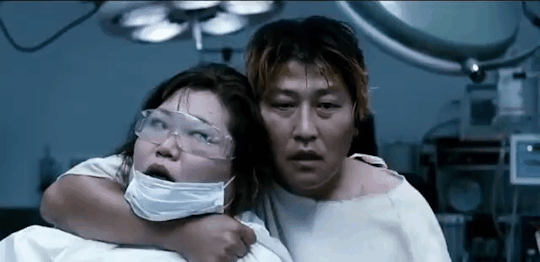
Nam-il wakes up at the same time, not accompanied by a homeless man (Yoon Je-moon), who agrees to take him to the bridge to find Hyun-seo. In the sewer, the two kids have survived, and the creature appears to be asleep. Like a GODDAMN BOSS, she runs up the creatures back, and jumps onto a rope that she had made, and that was hanging far out of her reach. Unfortunately...the creature catches her with its tail. Fuck. It sets her down, and...lets her go? But as soon as she runs, it attacks bother her and Se-joo.
Just then, Gang-du gets to the lair, and uses the rope to climb down. Below him is a pile of bones, and no kids to be seen. The creature goes by, and Hyun-seo’s hand is dangling out of its mouth. And once again by coincidence, that’s when Nam-joo wakes up and reunites with her brother. The creature runs to the waterfront, only to be greeted by...a crowd? They’re gathered there to protest the release of the dangerous chemical into the river.
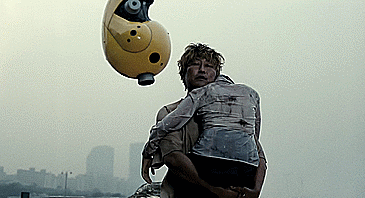
It all collides at once. The creature swims towards the crowd, Gang-du runs towards the creature, Agent Yellow is released over them both, causing the creature to faint. Gan-du runs up and grabs the bodies of his daughter and See-joo from its mouth, apparently too fucking late. Shit, man. This would’ve been avoided if they just HELPED him. Fuck. He carries her body away as more chemical is released onto the flailing creature, and the chemical causes everyone else in the area to violently hemorrhage as well. Meanwhile, Nam-il and Nam-joo arrive to see their deceased niece, grieving all over again. It’s...fuck, man, it sucks.

And Gang-du is fucking PISSED NOW. He grabs a street sign and attacks the injured creature, fueled by pure rage. Nam-il joins in with Molotov cocktails as it runs away. The homeless man douses it with gasoline, and that makes it easier for Nam-il to set it on fire...until he drops the bottle. And then, Nam-joo uses it to light an arrow on fire, hitting the creature with it, and setting it ablaze. It runs to the water, only for Gang-du to stab it through the head with the street sign, finally killing it in revenge for his father and his daughter. Fucking bad-ASS. And also quite tragic, given the circumstances.
And despite the tragedy, there is one happy circumstance: Se-joo lives! In fact, Hyun-seo died saving his life, like the real goddamn hero of this story that she is. Fuck. That’s terrible, but I’m happy that her sacrifice wasn’t in vain. From here, we fast-forward to the winter, where a clean-shaven and well-kept Gang-du is is now caring for Se-joo. The news is on in the background, but the two ignore it, happily eating together after the ordeal they’ve been through.
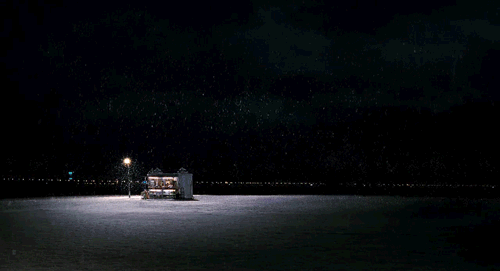
Whoof. That’s The Host, or Gwoemul! And yeah, that’s one hell of a movie, I tell you what. For a monster movie, it’s quite dramatic, and they don’t try to humanize the monster AT ALL. And honestly, I really like it! A Pyrrhic victory at the end, but nothing wrong with that! I’ll elaorate a bit in the review! See you there!
#the host 2005#bong joon-ho#song kang-ho#byun hee-bong#park hae-il#bae doona#go ah-sung#gwoemul#괴물#science fiction may#sci-fi may#user365#365 movie challenge#365 movies 365 days#365 Days 365 Movies#365 movies a year#korean cinema
11 notes
·
View notes
Text
The Road To “Godzilla VS. Kong”, Day One
KING KONG VS. GODZILLA (AMERICAN VERSION)

Originally Released: June 26th, 1963
Director: Ishiro Honda
Writers: Shinichi Sekizawa, Paul Mason and Bruce Howard
Starring: Tadao Takashima, Kenji Sahara, Ichiro Arashima, Mie Hama, Michael Keith, Harry Halcomb
youtube
“King Kong VS. Godzilla” is a movie whose reputation often precedes it amongst certain circles of Genre Film fans. Even if one is unaware of the convoluted, more than slightly seedy story behind its creation (short version: the original “King Kong”’s special-effects artist, Willis O’Brien, was interested in creating a sequel that would have pitted Kong against a giant animalistic version of the Frakenstein Monster, but shady producer John Beck wound up stealing the idea and, when American studios balked at the project for fear that the use of stop-motion animation to realize the effects work would be too expensive, wound up shopping it to the more cost-effective Toho Studios in Japan, who reconceived it as a new “Godzilla” project in hopes of revitalizing interest in the character), it is still one of the most singularly important Giant Monster Movies ever made. For one thing, it basically defined The Kaiju Movie as we know it today; sure, the original “Gojira” from 1954 (and by extension its Americanized adaptation, “Godzilla: King of the Monsters” in 1956) may have effectively created the genre, but you’ll notice the majority of such movies that exist today are more about Fanciful Title Bouts between two Clashing Monsters rather than somber moody Allegories about the horrors of Nuclear Weapons. For another, it’s the movie that really put Godzilla himself on the map as a Big Star in his own right; at the time, he only had two prior films to his name, and while one of them was the aforementioned genre-creating watershed “Gojira”, the other was “Godzilla’s Counterattack” from 1956, which proved such a box-office disappointment that it put the character into retirement for the better part of a decade (and to give you a sense of just how much less weight the name “Godzilla” carried back then, when that movie was released in America in 1959, it was initially re-titled “Gigantis The Fire Monster”). With “King Kong VS. Godzilla”, however, he would begin to star in more and more movies, building a film franchise that continues to this day.
So it’s a bit of a shame that I’ve never liked it all that much.
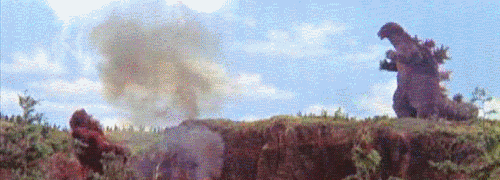
To be clear, the “it” in question here is specifically the American version of the movie, which is the one most Western audiences would be familiar with since, until recently, it was the only one readily available to us (though Criterion finally corrected that back in 2019, when they included the original Japanese version of the movie as a bonus feature in their “Showa Era” collector’s set). Certainly, it’s the one that I grew up watching as a kid, when my mom, ever so protective and knowing how easily upset I could be when Fictional Characters I Loved got hurt, made sure to watch ahead to see who exactly won the title match-up (and since it was Kong, I wouldn’t actually get around to finishing my viewing of the movie for a good long while). Back then, of course, I viewed it very much through that childish prism of who I thought should win, and it was exactly the kind of Schoolyard Logic you’d expect: Kong was supposed to be a great deal smaller than Godzilla, and where Godzilla had his iconic fire breath, Kong had no extraordinary powers; Kid Me understandably concluded that this match-up really ought to be a shoe-in for Godzilla, which worked out well since Godzilla just so happened to be the one Kid Me actually cared about. Kid Me was thus quite irritated to discover that, for the sake of this movie, Kong had in fact been significantly sized up and given random electricity-absorbing powers. It felt like cheating to Kid Me, and it left me less than positively disposed towards the film proper.
These days, of course, I’m able to give the film a somewhat fairer shake, though I would be lying if I said that My Inner Childish Fan-Boy is completely quiet on the matter (in particular, it always bothers me that, to emphasize the advantage Kong’s electrical powers give him in their fight, the movie explicitly cites Godzilla’s “vulnerability” to electricity, despite one of the most singularly iconic images of the original “Gojira” being his ability to walk straight through a power-line barricade). Indeed, my most recent re-watch for this very review honestly left me feeling fonder toward it than I was even on my last most recent re-watch (back in 2014, in preparation for the then-upcoming Gareth Edwards “Godzillla”, which we’ll also be getting to in this re-watch soon). The portrayal of the title monsters themselves in particular left me much happier this time around than it has in the past; the design for Godzilla himself- thick around the center with big heavy-browed eyes and what appears to be a constantly self-amused grin, huge sharp claws that dominate the fingers and a tail that moves with a real sense of weight and purpose-took me a long time to warm up to, for example, but these days I would happily cite it as one of the very best of the original series. Kong gets it a bit worse, sadly; the suit they design for him here (a fact that original “Kong” director Merian C. Cooper openly despised, incidentally; the idea of portraying Kong as just some guy in a gorilla costume was one of the things he explicitly set out to avoid in the original movie) has a distinctive enough face if not an especially memorable one, but the costume always looks and feels a bit raggedy, with the sagging pecs and ill-fitted arms (throughout the movie the suit switches between “regular” arms designed to allow the actor mobility, and extended arms to help give it a more ape-like gait; the result is that both versions feel weirdly out of place on the costume a lot of the time) looking especially awkward. However, even beyond how they look, the way the monsters act is genuinely enjoyable, with Haruo Nakajima as Godzilla and Shoichi Hirose as Kong both putting in fantastic performances that imbue them with a great sense of personality that is just consistently delightful all movie long. Whether it’s Godzilla hopping around, arms flailing in triumph whenever he manages to pull off another victory, or Kong drunkenly swallowing up giant pots’ worth of a narcotic usd to keep him docile, the movie very visibly delights in imbuing these creatures with fun foibles, and It’s no coincidence that the it’s at its strongest, not so much when the monsters are fighting, but when they are simply interacting as actual Characters: Godzilla here feels often like a particularly arrogant, boundlessly-energized child, while Kong is a bit more confused and subdued but quick to anger when irritated; their first meeting, when both these strong visible personalities most openly bounce off each other, is unquestionably my favorite moment of the movie.
The rest of it isn’t exactly bad, per se, but it is a lot less entertaining. Some of that is simply what the American version inherited from the Japanese original, not least of all the noxiously racist portrayal of the Natives living on a remote pacific island with Kong (here named “Faro Island” for some reason instead of the usual “Skull Island”). On top of the sins it recreates from the original “King Kong” (a fairly ooga-booga understanding of What Islanders Are Like, all of whom are portrayed by non-Native actors slathered in brownface make-up), it also includes a decently insulting bit wherein the initially-hostile islanders are pacified by the introduction of “magic” in the form of a hand-held radio and cartons of cigarettes. There’s also the fact that the plot is driven almost entirely by Random Contrivance rather than anything that flows naturally from either the characters or the premise; Godzilla and Kong have no real compelling reason to meet, let alone fight, other than the pure coincidence of their both happening to be active at around the same time in the same part of the world (the American version attempts to ameliorate this somewhat by stating that the two are “instinctive rivals” who will be “naturally driven to destroy one another”, but that flimsy lip-service to Motivation just winds up making the otherwise-arbitrary plotting feel all the worse), and we are constantly bombarded by Total Coincidences as a way of shuffling the characters around from place to place with dizzying frequency. But some of those troubles are only exacerbated by the approach the American version has taken to the material. We’ll talk about this more tomorrow, but the Japanese “King Kong VS. Godzilla” is, at heart, a Satirical Comedy; this, unsurprisingly, was not an idea that went over well with Universal Studios in America, who chose to try and reshape that comedy into a more traditional Monster Movie. An understandable objective, but not one the Japanese cut of the film made easy to achieve; to avoid the most overt Comic bits meant cutting almost all of the human characters in the film (most notably the eccentric executive Mr. Tako, played by Ichiro Arishima) down to only their most essential appearances, which in turn means that they all wind up feeling vaguely undefined and out of place in their own story (this feels especially true of our ostensible main character, Tadao Takashima‘s Sakurai, who is present enough to FEEL like a main character but has little left to do in this cut of the film). To make up the weight of all that cut footage, meanwhile, we get gobs of new footage consisting mostly of Michael Keith as a United Nations reporter talking at us in the most stultifying way possible, often joined by Harry Holcombe as an equally stultifying scientist (who apparently gets his knowledge of dinosaurs primarily from children’s picture books, which in fairness would explain a lot of the nonsense he ends up saying), though he also frequently talks with a fellow reporter played by James Yagi. These scenes are not, perhaps, without their charms, but they also deaden the movie’s pacing, especially since nine times out of ten they exist mostly to reiterate stuff we already know because it literally just happened. Given how much a faster pace seems to be one of the American cut’s top priorities (a sub-plot from the Japanese version about a submarine inadvertently encountering Godzilla is reduced to a single sequence for this version), that choice proves a counterintuitive one.
Because the other major problem with the American approach to this movie is that, to be frank, the Monster Action is nowhere near Epic enough to bear the weight this new cut puts on it. Again, it’s not without its merits; Godzilla and Kong’s outsized personalities do a lot to lend even the less effective sequences a certain fun spirit, and there is still an unmistakably strong sense of craftsmanship to the miniatures used throughout the movie to create the appropriate sense of scale for our Monsters to play around in (the demolition of a recreation of Atami Castle shines a spotlight on that very fact). But in terms of both their scope and their choreography, there’s just not enough There there; far too often, “King Kong VS. Godzilla”’s Big Marquee Action Scenes amount to the monsters just sort of lazily throwing rocks at each other, or else engaging in less-interesting recreations of their previous Iconic Moments (Kong especially goes through a truncated version of his original appearance’s third act, though here he ends up on top of the National Diet Building rather than the Empire State Building). That’s slightly less of a problem in the Japanese version; again, there, the main thrust of the film lies in its comedy, and thus the Monster Action being relatively lightweight is less of a hinderance and more a spicy Flavoring to the main story. But here, it is the main story, and while it’s pretty clear some real love went into the Effects Work (the puppetry especially is very solid; there are a few instances where the switch from Suit Actor to Puppet for Godzilla is borderline seamless, and I also enjoy the decently-animated feel of Kong’s facial puppet as well) it ultimately doesn’t have nearly enough substance to fill that role. This comes through especially clearly in the Final Showdown between the monsters; again, there is some deservedly iconic stuff here (Kong trying to shove a tree down Godzilla’s throat only to have it rebuffed in a puff of flames has become an impressively-enduring Meme for a reason) but, much like most of the story, winds up being driven far more by Contrivance than anything clever or satisfying (a bit where Kong knocks himself over feels especially annoying for how unmotivated it seems to be). It was always going to be a tall order to make a match-up with as much implicit weight to it (both metaphorical and literal) live up to the heightened expectations placed on it, maybe. But even taking that into account, it’s hard not to feel like “King Kong VS. Godzilla” could have put a little more effort into things.
Still, I was saying, at the start, that I walked away from “King Kong VS. Godzilla” happier this time than in many of my past viewings. And that is ultimately true: for as much as I find myself often wishing it could be a different movie, the movie it actually is already does manage to work decently well on its own terms. The dub-work here in particular honestly deserves notice; in contrast to the standardized casts Toho would start using for most of its “Godzilla” movies moving forward, here we get a more distinctive sounding voice-cast who manage to put some real Life into their performances (the voice they give to Kenji Sahara’s Fujita stands out especially to me, nasally and over-earnest but capable of some real Fire when the moment calls for it, as befits the character). And, again, whatever my beef with the Action Scenes, the actual portrayal of the Monsters really is uniquely fun (indeed, given how many other elements Toho would consistently crib from it, I’m often surprised that Godzilla’s distinctive body language throughout isn’t one of them), which winds up giving the movie enough Real Heart in the end to make it a positive Experience overall, even against the stuff that even now stands out to me as Not Up To Snuff. At the very least, it’s a lot easier for me to recognize how and why this movie created the Legacy it did, even if the American Version makes a bit more of a mess out of it.
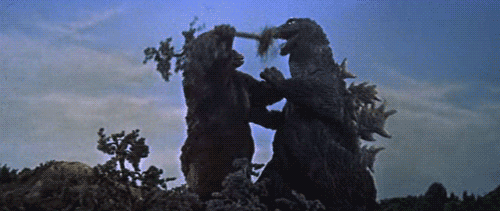
#godzilla#king kong#godzilla vs. kong#kaiju#theroadtogvk#movies#review#ericthemason#my writing#king kong vs. godzilla
6 notes
·
View notes
Text
So right now I'm reading Writing Japanese Monsters by John LeMay, which provides some details on the writing development behind kaiju movies. A few interesting things I didn't know:
1. Rodan is actually an adaptation of a short story that was published in Boys Magazine titled The Birth of Rodan. Basically, the genesis of Rodan lies with the original but never produced concept for the third Godzilla movie, Bride of Godzilla - the script included an underground cavern with ancient insects and an Archaeopteryx type monster. Even though it was never made, Tanaka liked those elements enough that he suggested to horror novelist Ken Kuronuma they'd make for a good story themselves. Kuronuma agreed, and the result was The Birth of Rodan. According to the book, the biggest difference between the story laid out in Birth of Rodan versus the final film is that there was only one Rodan and he was defeated by the end by being blasted with freeze bombs. (Also, apparently the Rodans' double-suicide at the end was a last-second change inspired by an on-set accident when one of the Rodan puppets accidentally caught fire. And the scene where newly-hatched Rodan eats the Meganurons was suggested by Akira Kurosawa while he and Ishiro Honda were hanging out one night while the film was being developed.)
2. The Mysterians began life as a novel written by Jojiro Okami titled Earth Defense Forces. He was shopping it around when he met and befriended Tanaka's brother, who liked the idea and introduced Okami to Tanaka. Tanaka tried to help him get the book published, but when that didn't pan out instead handed it to screenwriters to develop into what became the Toho film.
3. I already knew that the movie Mothra was an adaptation of the novel The Luminous Fairies and Mothra by Shinichiro Nakamura, Takehiko Fukunaga, and Yoshie Hotta. But, what I didn't know: the story that the original ending had the heroes chase the villains into the mountains outside Tokyo and that it was Columbia Pictures which suggested the New Kirk City attack sequence is actually false. Mothra travels to Rolisica in the novel too in her quest to rescue the fairies - unlike the the movie, instead of dying in a shootout with police the villain is instead killed by a Good Samaritan who recognizes him and takes it upon himself to save the fairies. (There's actually a LOT different between the book and the movie, based on the descriptions here.) While adapting the book Toho decided to scale the story back in the hopes of securing financing, and by the time they did so they'd already shot part of the film including the scaled-back ending. But, Columbia actually insisted that the movie go with the original ending that way they could have Mothra in an American-looking city. Their other request was that they change the city's name - in the book, it's the fairly silly-sounding New Wagon City. Shinichi Sekizawa (the screenwriter) suggested Newark as a new name, which is what they were going to with until Jerry Ito (the actor cast as Nelson) pointed out that Newark, New Jersey is a real city. They didn't want to use a real city's name, so they changed it again to New Kirk.
Next chapter is on Gorath and The Last War!
35 notes
·
View notes
Text
Kaiju Week in Review (March 26-April 1, 2023)

Sadao Iizuka died on March 24 at the age of 88. One of the last living links to the first Godzilla film, he had an incredibly prolific career in tokusatsu as an optical artist, with his work including Godzilla's atomic breath, King Ghidorah's gravity beams, and Ultraman's specium ray. Most of his work on Toho kaiju films was in the Showa era, but he also contributed animation to every one from 1993 to 1997, plus Final Wars and, believe it or not, Shin Ultraman. Rest in peace.
If you'd like to learn more about his career, Brett Homenick published a couple of very expansive interviews here and here.

Chibi Godzilla Raids Again premiered on April Fools Day with a lot of bickering between the worldly Chibi Mechagodzilla and the sweet Chibi Godzilla. No official translation yet, but fellow Wikizilla bureaucrat Les went through the on-screen captions to write a lengthy summary.
youtube
Godziban is celebrating Godzilla vs. Megalon's 50th with a multipart episode, the first installment of which also went up on April Fools' Day. The Three Godzilla Brothers get the filmmaking itch again, and Gigan and Megalon are as gloriously dumb as ever.

Kamen Rider and Man Spider—sorry, "Masked Rider" and "Kumo Augment"—have joined Godzilla Battle Line. With this, every lead from the Shin Japan Heroes Universe is part of the game, making it one of the most elaborate Godzilla crossovers ever (remember, Kong's there too). I doubt Rider actually becomes kaiju-sized in Shin Kamen Rider, but there is some precedent for it. Both units are apparently game-changers too.

Penguin will be publishing a Godzilla picture book the day after Christmas by Olivia Luchini, titled Love from Godzilla. No cover yet, but here's the description:
Share the love with Godzilla! This hardcover gift book, complete with monstrously adorable illustrations of everyone’s favorite kaijus, is perfect for that special someone.
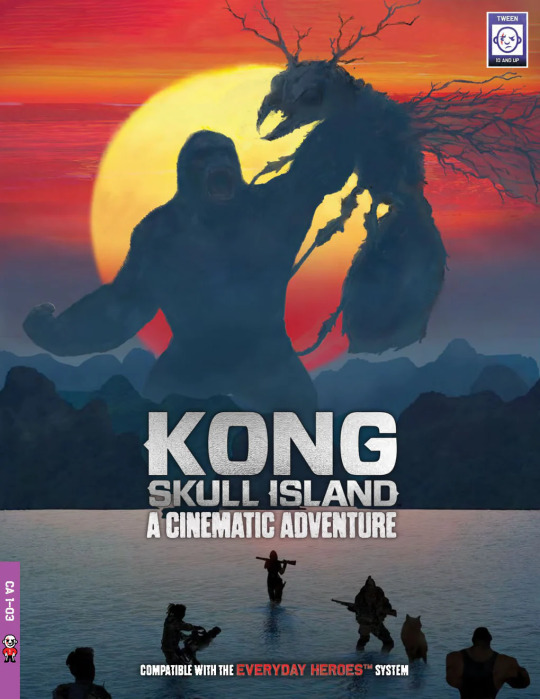
Sick of the Skull Island cartoon taking forever to come out? Make your own story. Evil Genius Games has opened preorders for its Kong: Skull Island Cinematic Adventure RPG, to be released on June 1, although you can buy the PDF right now. As someone whose introduction to tabletop RPGs was Toho Kingdom's D20 section, I'm beyond thrilled, not the least because the book thanks Wikizilla and our resident King Kong expert, The Boy Who Cried Godzilla. And as you can see, there are some new monsters in the mix.
Preorders are also open for their Pacific Rim RPG; same release date. They're hoping to expand on both via crowdfunding; the Kickstarter starts May 9.
youtube
Bandai released a short, baffling video about an unspecified Shin Japan Heroes Universe project on April Fools' Day. Very suspicious timing, but there's nothing in here that really reads as a prank; this crossover has been around for a while now. Cool animation too.
Toho didn't do anything Godzilla-related for 4/1 this year, probably to avoid upstaging the shows that released actual episodes that day. But I did write a Wikizilla article on past pranks if you'd like a stroll down memory lane.
#kaiju week in review#sadao iizuka#chibi godzilla raids again#shin japan heroes universe#godzilla battle line#godziban#godzilla#kong skull island#love for godzilla#shin kamen rider#kamen rider#king kong#kaiju
36 notes
·
View notes
Text
Return of the King (King Kong vs. Godzilla, 1962)
It’s difficult to overstate the impact of King Kong vs. Godzilla, the third movie in what was to become the Godzilla series and the first to be shot in color, yet a movie that has also been almost completely overshadowed by everything that came after. Produced to coincide with Toho’s 30th anniversary, King Kong vs. Godzilla was the most ambitious kaiju movie to date, a landmark production involving two of the most famous movie monsters put on screen. To try and give a modern day comparison, this was the equivalent of the first Avengers movie or Avatar (remember Avatar??)
That said, something tells me if you’re out looking for a Godzilla movie from this era, you’d pop in vs. Mothra or Mechagodzilla or one of the other more popular entries. The fact that until 2019, the only legal version that most of us in the west could get our hands on was the inferior English cut due to a licensing agreement between RKO (the original owners of King Kong) and Toho didn’t exactly help either.
But really it goes deeper than that. King Kong vs. Godzilla is a downright weird movie no matter which version you watch. And I’ve seen both of them, the Japanese cut a few times and the American version exactly once last night, since it came with my Criterion Blu Ray set. More importantly, that set came with a decent restoration of the notoriously shitty-looking Japanese cut, and represents the first time that version was ever legally available stateside, so that’s nice!
The Japanese cut was put together by the usual crew, with Ishiro Honda directing, Eiji Tsuburaya on effects, Akira Ifukube on soundtrack duties, and Tomoyuki Tanaka producing. The writer is again Shinichi Sekizawa, though from what I’ve read, the sheer wackiness of the plot has more to do with Honda and Tsuburaya than it does Sekizawa, though I highly doubt he wasn’t an unwilling partner in all this.
The main plot (of the Japanese cut at least) is that the constantly riled up Mr. Tako (Ichiro Arihima) is tired of the TV shows his pharmaceutical company produces bombing in the ratings, so when he hears of the news that a giant monster has been sighted in the south pacific, he sends two of the salarymen in his employ off on an adventure to bring the monster to Japan so they can make a TV show about it.
This plot, frankly, is fucking ridiculous. Even knowing what comes later in Godzilla’s career, it’s really difficult to take the first half of this movie seriously, and even when the second half introduces some tension, it barely ever lasts, usually foiled by the monsters mugging and clapping, or the antics of Mr. Tako and his two cohorts.
This was, in part, Honda’s idea. He had apparently been disgusted with the “ratings wars” numerous TV producers were engaged in at the time, and took that idea to its logical extreme by making a TV producer start a literal monster war.
And go to war they certainly do. Sakurai and Fujita, Mr. Tako’s subordinates, bring Kong back from the island just in time for Godzilla to pop out of the arctic fresh from his seven year nap after Godzilla Raids Again, and after some general dicking around they go at it for the first of two times, and the results are... interesting. Tsuburaya apparently wanted to take the monster action in a lighter, more family-friendly direction, a move which Honda was very much opposed to. The result is the inception of the boulder-flinging (get used to it) and a lot of mugging and general wackiness that couldn’t be more different from the animal savagery in Raids Again. Harou Nakajima and Shoichi Hirose, who played Godzilla and Kong respectively, apparently did their own choreography, and took a lot of their inspiration from pro wrestling.
It’s here that I’ll bring up the effects which, sufficed to say, are a disappointment. While the few city sets that the film shows look good, Kong sure as hell does not. With a dopey, blinking face and ratty fur, Kong looks like an old rug somebody forgot to throw out. Godzilla fares quite a bit better in his first color appearance, with a mean, angular face and great proportions. The matte work used to put the human characters in the same scenes as the monsters is downright repugnant, and has been done better in earlier movies. I’m inclined to think it was just that Tsuburaya’s team bit off more than they could chew, but it’s still hard to look at the effects of a movie this big and see literal green screen outlines around the main cast.
That said, the movie is still a fun watch, if only to try and make sense of it all. Kong miraculously gains the ability to eat lightning, (a relic from when the movie was planned to be a Frankenstein vehicle, let’s not get into it) Akihiko Hirata has a small role as a doctor, and this also is the first movie to use Ifukube’s famous Godzilla theme.
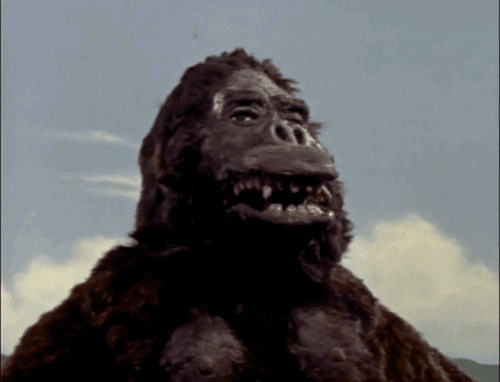
Almost none of these praises can be sung of the American version, which is a dreadful and boring disaster of a movie that seems to have had a singular objective of making as little sense as possible.
The team producing the English dub did have their work cut out for them, if I can say this one thing in their defense. The plot they had to work with of a deranged TV producer sending his underlings out to bring back a monster in order to boost ratings was so distinctly Japanese that, instead of trying to work with it, they just threw it out entirely.
Well, they threw out as much as they could. Sakurai and Fujita’s expedition to Faro Island and their retrieval of Kong takes up a significant portion of the film’s first act, to the point that they’re so integral to the plot that you really can‘t remove them and then explain where the hell Kong even came from.
The English cut solves this problem by trimming their appearances down to the sheerest atoms of footage they could, resulting in a movie that has no real protagonist or focal point at all. While Mr. Tako and his dynamic duo were hardly great protagonists, they at least have some claim to the title. Characters from the Japanese cut whizz by with the slightest possible introductions when they get one at all, leading the viewer to not understand what the hell they’re doing their in the first place.
In place of the original plot, we get a pair of talking head newscasters and a doctor who reads dinosaur facts out of a big picture book. I would have been alright with the removal of the original plot if what they’d replaced it with was worth something, but this just isn’t. The general plan was to present the movie as if it was being told through a newscast, meaning that many of the new actors stare unnervingly into the camera while reading their lines, which are often presented with the complete absence of emotion, befitting the detached newscaster aesthetic. Not to mention there’s something really disappointing about seeing shots that were simply part of the movie in the Japanese cut shrunk down to the size of a TV screen in the English version just to service this frame story that’s not worth shifting focus to.
To give them credit, this strategy worked for the American edit of the original Godzilla, a movie I decided not to cover due to the fact that it’s generally fine at what it does in that it tells the story through an American narrator but generally leaves the plot alone. Not so here, where the bizarre first half is replaced by something equal parts confusing and dull, with stock Universal monster music replacing Ifukube’s score to boot. They did at least dub over the American submarine crew who become Godzilla food, who sound like they’re reading their lines at gunpoint in the Japanese cut.
I don’t hate this movie, though it may seem like I do. King Kong vs. Godzilla is more of a mixed bag than anything else, a film that’s remembered more for what it started than what it is. Pretty much every Godzilla sequel we’re in for follows the whimsical template that started here, and whether that’s good or not is totally your call. But we did get Godzilla’s infamous dropkick out of the deal, so it isn’t all bad. Watch the Japanese version while you wait for Godzilla vs. Kong to come out, but stay far away from the English cut.
8 notes
·
View notes
Photo










怪獣ジャイアント サンダ - “Monster Giant Sanda” (1972)
#toho kaiju picture book#sanda#brown gargantua#gaira#green gargantua#giant octopus#gorosaurus#東宝怪獣絵本#サンダ#ガイラ#大ダコ#ゴロザウルス
223 notes
·
View notes
Photo







The cover and some scans of a Godzilla picture book from the late 1960s/early 1970s.
315 notes
·
View notes
Text
Gorgo
I recently rewatched Gorgo, a 1961 US / UK / Irish kaiju co-production, a film I hadn’t seen in several years (at least five, maybe as many as ten).
The last couple of times I watched it I wasn’t paying close attention, just letting it play in the background as I did other stuff.
Now, having actually paid attention to it again, I’m delighted it holds up as well as my memory told me it did.
I first encountered Gorgo in 1961 when my father took my younger brother and I to see it as the Fine Arts Theater in Asheville, NC.
The Fine Arts, one of only two movie theaters in Asheville (there may have been a 3rd that I didn’t know about due to the segregation laws of that era) specialized in more outre’ fare and typically got the monster and horror shows, as well as the Hercules movies and =ahem!= adult dramas.
It was a memorable trip for several reasons, not the least of which being my younger brother freaking out at the climax when he turned to grab Dad’s arm only to find Dad had gone to the rest room.
Not a great movie but certainly a good one, Gorgo in retrospect was somewhat groundbreaking and as such more deserving of attention.
The late film historian Bill Warren and I would often discuss old sci-fi movies. Bill, of course, wrote the seminal reference work on 1950s sci-fi movies, Keep Watching The Skies (highly recommended; go order it right now).
He argued that the fifties sci-fi boom may have started in 1950* but it really ended in 1962 when the last of the films put into production in the 1950s finally came out.
I argued that the line was fuzzier, greyer, with some titles showing a clearly different mindset than others released the same year.
Such is the case with Gorgo.
Basically, 1950s sci-fi is about re-establishing the status quo. Several end quite explicitly stating this (Earth Vs. The Flying Saucers for one) while others allude to the fact that the menace may return…someday.
But their point always was that by the end of the picture things returned to what passed for normal.
Even Forbidden Planet returns to normal by destroying Altair IV and the truly god-like Krell machines found there, thus preventing anyone else from using them.
But 1960s sci-fi had an entirely different flavor, and that flavor was that by the end of the movie things had changed irrevocably and forever.
There was no going back to the way things were, there was only the new normal -- however different and bizarre that normal might be.
Gorgo is a sixties sci-fi film.
Giant monster movies -- what we now refer to as kaiju due to Japan’s dominance of the genre -- started way back in the silent era (like almost everything else in cinema, Georges Melies got there first) with King Kong as the most prominent example before the atom age.
King Kong’s success on TV in the late 40s spurred Warner Bros. to make The Beast From 20,000 Fathoms and that in turn spurred Toho to make Gojira (US title: Godzilla, King Of The Monsters) and that inspired a giant monster race on both sides of the Pacific.
England, not wanting to feel left out of the fun, made The Giant Behemoth which is an okay but underwhelming example of the genre, noteworthy only for being stop motion animators Willis O’Brien’s last feature work (he worked on other films after that, but not as an animator).
By the late 1950s Godzilla’s popularity inspired the King brothers (US slot machine distributors) to make their own giant monster movie, and despite their unfamiliarity with the genre they made several smart decisions, the first of which was hiring Eugene Lourie.
Lourie had one of those fabulous “cast your fate to the wind” careers that included working as art director on Jean Renoir films in France.
Like so many others, as the Nazis rose in power, Lourie came to America where he continued doing art direction among other behind the camera film work. His experience with special effects got him a gig direction The Beast From 20,000 Fathoms and from there he directed a few TV episodes then The Colossus Of New York (not what we’d call a kaiju film today, but definitely one of the oddest sci-fi movies ever made) and The Giant Behemoth (itself essentially a remake of The Beast From 20,000 Fathoms).
When the King brothers approached him to direct Gorgo, he was reluctant, agreeing to make the film only they let him do something no other sci-fi film of the 1950s (or before!) had ever done: Let the monsters win.
While Lourie later complained he felt the film fell short of what he intended, there’s no denying he was swinging for the outfield fence with this one.
The King brothers’ best idea was that they’d start with a 20-ft tall monster getting captured and brought to London, only for the protagonists to belatedly realize they’ve captured a baby and mama is gonna come looking for him.
It ends with Mama defeating everything humanity had to throw at it and returning to the sea with her child, the surviving humans watching them depart and realizing they can no longer consider themselves the absolute masters of all they survey.
That point gets lost in the feel-good moment of mother rescuing child, but it’s there, and it marks Gorgo as one of the first sci-fi films to embrace the concept that change was inevitable and inescapable.
Gorgo is an expertly crafted film, not perfect by a long shot, but satisfying all the way through. Lourie’s talent as an art director contributed mightily to the film’s final dramatic effect, and the scenes of London panicking as Mama Gorgo comes looking for her child has an intensity lacking in most kaiju films.
As Bill Warren observed, there’s not a lot of originality here, but that’s okay because Lourie and the King brothers covered a number of details typically left out of movies like this, namely how the %#$@ are you going to get your kaiju back to civilization?
Sharp eyed observers will notice a lot of stock footage in this movie (with footage of the British and US navies being used interchangeably for the same ships and crews), but Lourie also disguised some of it well.
The cost conscious King brothers filmed a lorry carrying a full size replica of Gorgo (doped up and trussed up with nets) through a deserted Piccadilly Circus by sneaking cameras in and doing a wholly unauthorized shoot early on a Sunday morning (explained away in the film as the police ordering people off the streets to reduce the danger of Gorgo escaping).
In a couple of scenes Lourie superimposes his actors over background plates shot for big budget WWII epics, creating a far larger sense of scale than the movie actually had.
The miniatures and the lighting of same are exceptionally well done and very convincing for the era. Matte work to combine the Gorgos with humans is pretty seamless.
The Gorgo monster suit itself? Ehhh…not quite so well done. Call it adequate, certainly not an embarrassment, but far from the best example of the genre.
The movie certainly ended in a far different place than other kaiju of the era and ended up having a surprisingly long half-life as a comic book spin off by Steve Ditko that followed the adventures of Gorgo and his Mama.
There’s a lot that can be done with this kaiju combination, and it’s a shame that’s going to waste.
If ever there was a movie deserving of an upgraded remake, it’s Gorgo.
© Buzz Dixon
* When a particular epoch in pop culture starts / stops is always open to debate. Since Bill wouldn’t consider short films or serials in Keep Watching The Skies he omits several serials released before 1950 that anticipated the sci-fi boom, in particular The Purple Monster Strikes, the first of Republic’s Martian invasion serials as well as the first cinematic sci-fi excursion to include all of the key elements of 1950s American sci-fi: Paranoia, alien invasion, body possession. (For those keeping score at home, the Republic Martian serials are The Purple Monster Strikes, Flying Disc Man From Mars, and Zombies Of The Stratosphere though one can argue King Of The Rocket Men, Retik, The Moon Menace, and Commando Cody, Sky Marshall Of The Universe are crossovers of one kind or another; the first three serials were unintentionally linked when cost conscious Republic decided to recycle costumes and props and rewrote dialog to refer to prior releases in order to cover their budgetary limits.)
1 note
·
View note
Photo

☆Coming to the Mandarake Zenbu 98 Auction☆ Daimansai Festival Special Edition Cardcaptor Sakura Cel Opening cel. For your chance to buy this and over 3000 other amazing items, be sure to check out the link below to get your copy of the Mandarake Zenbu catalogue. As usual, the Mandarake Zenbu catalogue isn't just a mere auction guide, but it also has lots of interesting features, articles and interviews! The live auction gets underway on August 17 at 8pm, so be sure to get your pre-bids in if you can't join us for the big event. Pre-bids are open from August 1. Mandarake Zenbu 98: http://www.mandarake.co.jp/publish/zenbu/indexEn.html ● Kaiju Special Feature We have gathered a variety of Toho kaiju goods and toys. Pages upon pages of kaiju masterpieces. With over 700 pages, this one book alone will be a handy resource. ・ Magazines with Godzilla Boken-Oh, Manga-Oh, Shonen King, Shonen Sunday and others. Hand-drawn illustrations, autographs etc Just right for the kaiju special feature we have impressive kaiju pictures, actor autographs and more. ● Animation Cels and Anime Gengas Astro Boy (Tetsuwan Atom) - Astro's mysterious feet, Anne of Green Gables, Evangelion, Miyazaki, My Hero Academia and others. There are plenty of items in the anime cel and genga corner! ● Hand-drawn Illustrations, Shikishi and Manuscripts Since it's the Daimansai Festival we have a fantastic selection of items. Each item is wholesome in its own right, and you can see so many of them on the pages. Osamu Tezuka, Shotaro Ishinomori, Kazuo Umezu, Shigeru Mizuki, Jiro Kuwata, Akira Toriyama, Hirohiko Araki, Rumiko Takahashi, Ryoko Yamagishi and more. ● Tankobon (Single Volume Books) Part 1 of our post-war akahon manga special feature. Many akahon comics from Showa 23-24 (1948-49) including Kikuo Tagawa's Kyouryuu Sekai (with box) and Takeo Nagamatsu's Ogon Bat (Golden Bat) (with obi). There is also comicalised versions of Toho movies including Godzilla, Rodan (Radon), Chikyuu Boueigun, Ekitai Ningen to Bijo and more. ● New Size Books Mushi Comics' Little Ghost Q-Taro (Obake no Q-Taro) and more including complete sets with their obis. Norikazu Kawashima and Hideo Azuma special feature. ● Vintage Comic Magazines and Supplements Shogakukan Book (Shogakukan Comics) Kaiju Appendix Special Feature ● Doujinshi ・ Reference Material Hideo Azuma Special Feature The legendary lolicon doujinshis Cybele and Chokusan Azuma Magazine. We have plenty of items, old and recent! ・ Male Doujin Seihou Project Series Special Feature! It's been 20 years since the popular doujin game Touhou Project was released. This time we've got various items from a different danmaku shooting game, one created by the circle Amusement Makers of which Touhou Project creator Zun was was a member. ・ Female Doujin Osamu Tezuka parody special feature mainly focused on Black Jack ・ Shoujo Doujin Special feature on shoujo manga and shoujo groups, the flowers of the early Comic Markets. ● Cards Toho Kaiju and Tokusatsu Special Feature! Mini cards, bonus cards and so on. There's also Harimao no Densetsu, Meikin Story, Dekapachi Seal, candy packages with stickers and more. ● Dolls Tiny Betsy McCall Special Feature An 8 inch (20cm) doll released by Toner in 2000 with big eyes and a bobbed head. Formerly a paper pattern company, McCall sold paper patterns of clothing worn by Betsy in the May 1951 issue of McCall Magazine. It was a big hit and the famous little paper dress up doll became a real doll. The realistic figure and face of a young woman are real eye catchers. ● Voice Actor Goods Signed goods from recently popular voice actors and industry veterans. ● Vehicle Goods Tomica Foreign Cars Special Feature. ● Records and Cassettes Kaiju Cassette Special Feature. ● Railway Goods Line color framed station name plate, nicknamed plate Asakaze, side name plate Kashima Jingu ⇔ Shinjuku and others. ● Movie and Anime Posters Kaiju movie, movie theatre large promotional banner ● Kaiba and Other Books Special feature on UFOs including doujinshi, magazines, research books and many publications from a graduate school. There are also lots of other items including art, spiritual world and books signed by popular actresses. ● Cosplay It's the Daimansai Edition so let's look at cosplay outfits. We're exhibiting items focused mainly around uniforms. ● Baseball Feature on the Giants' Shinnosuke Abe. We have items that were actually used. https://www.facebook.com/mandarake/photos/a.621554837994524/1735342423282421/?type=3 Mandarake http://www.facebook.com/pages/p/621549997995008
2 notes
·
View notes